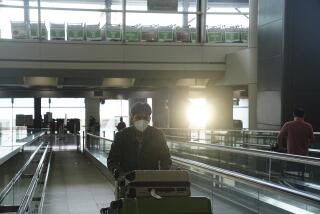Asia : Hong Kong’s New Airport Finally Gets Off Ground
- Share via
HONG KONG — Anyone who has flown into the airport here knows the gut-wrenching dogleg turn before landing, the plane skimming so close to crowded apartment blocks that passengers can almost see what the families inside are eating for dinner.
More than one plane has overshot the single runway and gone skidding into Hong Kong’s not-so-fragrant harbor.
“It’s like landing on an aircraft carrier,” says former astronaut James Van Hoften.
Van Hoften, now a vice president of San Francisco-based Bechtel Corp., is helping change all that.
He is supervising the construction of Hong Kong’s $20-billion airport, which will replace the overburdened Kai Tak, the world’s third-busiest airport, and some say its scariest.
The new airport, Chek Lap Kok, lands a different set of superlatives.
It is the world’s largest civil engineering project--with six times the cost of the giant new airport in Denver and built on a man-made island four miles square.
“It’s not the Great Wall, but you can see it from space,” says Van Hoften, pointing out the site on satellite photos with the practiced eye of the first civil engineer to ride in a rocket.
In the time it has taken the Denver International Airport to sort out its baggage-handling system, contractors in Hong Kong have quietly flattened a small mountain, created an island the size of Beverly Hills and started a suspension bridge longer than the Golden Gate to reach it.
And engineers promise that, even with projections of 87 million passengers coming and going, it will not sink, as has happened to the new airport in Osaka, Japan, which was built on reclaimed land.
The target date for completion is June 30, 1997--the final day of Britain’s sovereignty here.
Hong Kong’s last colonial governor, Chris Patten, could potentially pass the city’s keys to his Beijing-named successor in Chek Lap Kok’s VIP lounge.
But rather than representing cooperation between Hong Kong’s past and future rulers, the airport has instead become a symbol of Sino-British confrontation.
Britain decided to build Chek Lap Kok in the wake of the 1989 massacre at Tian An Men Square in Beijing as a morale booster for Hong Kong, a concrete show of Britain’s optimism that the onetime colony would remain international and autonomous.
To China, though, the implication that anyone lacked confidence in their rule was seditious.
The airport, Beijing claimed, was an extravagance designed to drain Hong Kong’s coffers before the territory reverts to China’s hands.
China withheld approval of the financing agreements, which straddled 1997, and during almost four years of talks, it looked as if the airport project would not fly.
“What it is really about is power and fear,” says a source close to the talks. “Sabotaging the project to punish Britain was a true case of cutting off one’s nose to spite the face.”
In November, after a four-year impasse, Beijing gave Hong Kong’s new airport the all-clear. While the politicians were haggling, workers from Poland to the Philippines quietly forged ahead with construction funded from Hong Kong’s reserves, building an airport on faith and sand from the sea.
Van Hoften tries to ignore the politics--he has enough international relations to worry about on the job. On one tunneling project, for example, the contractor was Dutch, the site observers were British and Polish workers started tunneling on one side to meet Thais digging in from the other.
“We’ve combined 10 projects under one team,” says Van Hoften. “It’s my job to make sure they all play together.”
More to Read
Sign up for Essential California
The most important California stories and recommendations in your inbox every morning.
You may occasionally receive promotional content from the Los Angeles Times.













